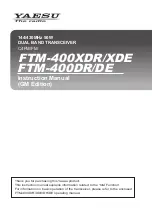
Strata Operations Guide
-
6 -
These back-off levels are carefully measured and configured as part of MRC factory adjustment
procedures and ensure digital mode RF output signals provide optimum performance. Therefore,
depending on what digital mode modulation format is selected, i.e., QPSK, 16 QAM or 64 QAM, or if an
HPU is used, previously configured transmitter back-off levels are applied to ensure the Strata TX RF
output signals operate with minimum Inter-Modulation Distortion (IMD). These carefully measured and
configured transmitter back-off levels are stored in the TXU IF/RF unit and are applied depending on
which particular operating mode is selected. Typical digital mode RF levels vary from 5 watts to 2 watts
output depending mostly on the modulation format selected.
Overall Operational Details
The following details apply when operating the Strata system using either the TCU or TXU front panel
controls:
1.
When companion TXU or TCU devices are inter-connected via coaxial cables, an inter-unit telemetry
link is established. This feature allows overall system operation and configuring to be accomplished
from either the TCU or TXU devices if both are used. For example, the microwave transmitter may
be keyed ON or OFF from either device.
2.
A configuration software tool (Strata TX Configurator) may be used to review and modify certain
system configuration options as described in this document.
Special Note:
All radio systems leaving the MRC factory are adjusted per standard industry (default)
settings, i.e., video and audio levels versus FM deviation (analog), as well as digital and analog IF and RF
levels, etc. In addition, transmitter back-off (IMD) and analog audio levels are carefully adjusted using
special software tools. Many of these settings are software controlled and cannot be adjusted in the field.
How to View Configuration Parameters and Control the TCU/TXU Units from the Front Panel
Figure 5 below shows the basic TCU/TXU control functionality using the front panel control switch:









































